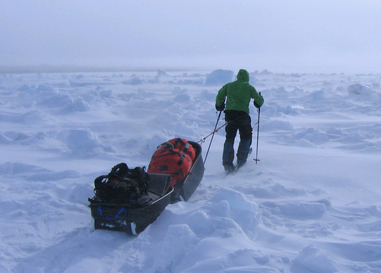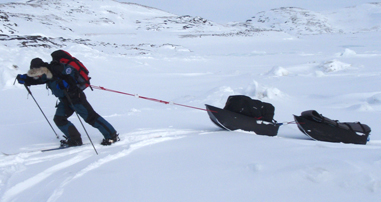One morning this winter, after waking in a tent pitched near the top of the world, Tyler Fish will check a compass and ski north toward mist undulating over open water. He will pull two sleds, each more than 100 pounds, to the water’s edge and gaze at a swath of Arctic Ocean deep and black between ice floes on route to the North Pole.
Fish, 34, of Ely, Minn., will then put on a waterproof suit. He’ll zip it up and ease into the ocean, the crush of cold closing in as he swims through saltwater, air pockets buoying a body backstroking across a void.

John Huston in Nunavut, Canada, training for the North Pole ski. Photo: Tyler Fish
The Arctic Ocean swim is one challenge Fish and partner John Huston are trained to face this winter on the Victorinox North Pole ’09 Expedition. Then there are the more expected obstacles — polar bears, ice fields, extreme cold — the team may encounter when, beginning in March, they head north from Canada’s Ellesmere Island in attempt to become the first Americans to ski unsupported to the North Pole.
It’s a 475-mile route polar veteran Richard Weber has described as “the hardest trek on the planet.”
“We are fully prepared to be overwhelmed,” said Fish, a cross-country ski racer and Outward Bound coordinator.
Polar Workday
Huston, 32, of Chicago, led an expedition earlier this year on the other side of the globe. He set a daily pace for a team of South-Pole-bound skiers to stride and push for 90 minutes at a time between water and food breaks, a strategy he and Fish will employ on their trip this March.
“You start to think of it as a normal workday, a nine-to-five routine,” said Huston, who successfully completed the South Pole trip after weeks of effort.

Tyler Fish leans into it during a training expedition on Baffin Island, March 2008. Photo: John Huston
On the North Pole expedition, it might be 60-below zero when the alarm beeps each morning. But Fish and Huston will unzip their sleeping bags and flick a stove to life. They will melt ice to make water, prepare breakfast, then get out of the shelter to start a new day.
An average leg of the journey — which has been accomplished by Russian, Norwegian and other teams, but no Americans — involves endless miles of skiing on a featureless plane. More challenging, immense fields of jumbled ice create a chaotic medium that takes hours to traverse. “It’s like the world’s biggest puzzle,” Fish said.










